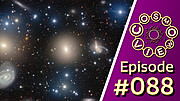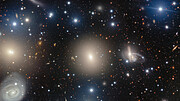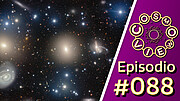Perseus Cluster & the Centaurus Cluster
Credit: Perseus Cluster: X-ray: NASA/CXC/SAO/V. Olivares et al.; Optical/IR: DSS; H-alpha: CFHT/SITELLE; Centaurus Cluster: X-ray: NASA/CXC/SAO/V. Olivaresi et al.; Optical/IR: NASA/ESA/STScI; H-alpha: ESO/VLT/MUSE; Image Processing: NASA/CXC/SAO/N. Wolk
Astronomers have taken a crucial step in showing that the most massive
black holes in the universe can create their own meals. Data from
NASA’s Chandra X-ray Observatory
and the Very Large Telescope (VLT) provide new evidence that outbursts
from black holes can help cool down gas to feed themselves.
This study was based on observations of seven
clusters of galaxies.
The centers of galaxy clusters contain the universe’s most massive
galaxies, which harbor huge black holes with masses ranging from
millions to tens of billions of times that of the Sun. Jets from these
black holes are driven by the black holes feasting on gas.
These images show two of the galaxy clusters in the study, the
Perseus Cluster and the Centaurus Cluster. Chandra data represented in
blue reveals
X-rays from filaments of hot gas, and data from the VLT, an
optical telescope in Chile, shows cooler filaments in red.
The results support a model where outbursts from the black holes trigger hot gas to cool and form narrow filaments of warm gas.
Turbulence in the gas also plays an important role in this triggering process.
According to this model, some of the warm gas in these filaments
should then flow into the centers of the galaxies to feed the black
holes, causing an outburst. The outburst causes more gas to cool and
feed the black holes, leading to further outbursts.
This model predicts there will be a relationship between the
brightness of filaments of hot and warm gas in the centers of galaxy
clusters. More specifically, in regions where the hot gas is brighter,
the warm gas should also be brighter. The team of astronomers has, for
the first time, discovered such a relationship, giving critical support
for the model.
This result also provides new understanding of these gas-filled
filaments, which are important not just for feeding black holes but also
for causing new stars to form. This advance was made possible by an
innovative technique that isolates the hot filaments in the Chandra
X-ray data from other structures, including large cavities in the hot
gas created by the black hole’s jets.
The newly found relationship for these filaments shows remarkable
similarity to the one found in the tails of jellyfish galaxies, which
have had gas stripped away from them as they travel through surrounding
gas, forming long tails. This similarity reveals an unexpected cosmic
connection between the two objects and implies a similar process is
occurring in these objects.
This work was led by Valeria Olivares from the University of Santiago
de Chile, and was published Monday in Nature Astronomy and
is available online.
The study brought together international experts in optical and X-ray
observations and simulations from the United States, Chile, Australia,
Canada, and Italy. The work relied on the capabilities of the MUSE
(Multi Unit Spectroscopic Explorer) instrument on the VLT, which
generates 3D views of the universe.
NASA's Marshall Space Flight Center in Huntsville, Alabama, manages
the Chandra program. The Smithsonian Astrophysical Observatory's Chandra
X-ray Center controls science operations from Cambridge, Massachusetts,
and flight operations from Burlington, Massachusetts.
Visual Description:
This release features composite images shown side-by-side of two different galaxy clusters, each with a central black hole surrounded by patches and filaments of gas. The galaxy clusters, known as Perseus and Centaurus, are two of seven galaxy clusters observed as part of an international study led by the University of Santiago de Chile.
In each image, a patch of purple with neon pink veins floats in the blackness of space, surrounded by flecks of light. At the center of each patch is a glowing, bright white dot. The bright white dots are black holes. The purple patches represent hot X-ray gas, and the neon pink veins represent filaments of warm gas. According to the model published in the study, jets from the black holes impact the hot X-ray gas. This gas cools into warm filaments, with some warm gas flowing back into the black hole. The return flow of warm gas causes jets to again cool the hot gas, triggering the cycle once again.
While the images of the two galaxy clusters are broadly similar, there are significant visual differences. In the image of the Perseus Cluster on the left, the surrounding flecks of light are larger and brighter, making the individual galaxies they represent easier to discern. Here, the purple gas has a blue tint, and the hot pink filaments appear solid, as if rendered with quivering strokes of a paintbrush. In the image of the Centaurus Cluster on the right, the purple gas appears softer, with a more diffuse quality. The filaments are rendered in more detail, with feathery edges, and gradation in color ranging from pale pink to neon red.
Fast Facts for Perseus Cluster:
Credit: X-ray: NASA/CXC/SAO/V. Olivares et al.; Optical/IR: DSS; H-alpha: CFHT/SITELLE; Image Processing: NASA/CXC/SAO/N. Wolk
Scale: Image is about 6.4 arcmin (450,000 light-years) across.
Category: Groups and Clusters of Galaxies
Coordinates (J2000): RA 3h 19m 47.71 | Dec +41° 31´ 15.8"
Constellation: Perseus
Observation Dates: 29 observations between Sep 20, 1999 and Nov 7, 2016
Observation Time: 416 hours 45 minutes (17 days 8 hours 45 minutes)
Obs. ID: 428, 502, 503, 3209, 3404, 1513, 4289, 4946, 4947, 3939-4953, 6139, 6145, 6146, 11713-11716, 12025, 12033, 12036, 12037, 19568, 19913-19915
Instrument: ACIS
References: Olivares, V. et al. 2025, Nature Astronomy; arXiv:2501.01902
Color Code: X-ray: blue; Optical: red, green, blue; H-alpha: red
Distance Estimate: About 240 million light-years from Earth
Fast Facts for Centaurus Cluster:
Credit: X-ray: NASA/CXC/SAO/V. Olivaresi et al.; Optical/IR: NASA/ESA/STScI; H-alpha: ESO/VLT/MUSE; Image Processing: NASA/CXC/SAO/N. Wolk
Scale: Image is about 1.4 arcmin (57,000 light-years) across.
Category: Groups and Clusters of Galaxies
Coordinates (J2000): RA 12h 48m 49.2s | Dec -41° 18´ 43.8"
Constellation: Centaurus
Observation Dates: 16 observations from May 22, 2000 to Jun 05, 2014
Observation Time: 240 hours 1 minute (10 days 1 minutes)
Obs. ID: 504 ,505 ,1560 ,4190, 4191, 4954, 4955 ,5310, 16223-16225 ,16534 ,16607-16610
Instrument: ACIS
References: Olivares, V. et al. 2025, Nature Astronomy; arXiv:2501.01902
Color Code: X-ray: blue; Optical/IR: red, green, blue; H-alpha: red
Distance Estimate: About 145 million light-years from Earth























